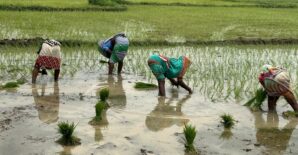Disruptions in the food value chain are becoming visible now. The government needs to recognise that ensuring adequate food and nutrition for the population is as essential as providing health services
The community spread of coronavirus can wreak havoc in India, as the population density is extremely high and the health infrastructure inadequate. To contain the Covid-19 pandemic, the government has shut the country down, including all the 7,000 wholesale agriculture markets. But the food value chain is as much an essential service as health services.
Tracing the virus, testing for its presence, and treating the disease is only one part of the challenge, say epidemiologists; the other, equally crucial part is ensuring adequate food and nutrition of its population. If economic activity ceases, and enough food is not delivered or many do not have the money to buy food of adequate nutritive value, we cannot defeat the disease.
Lockdown of the country to  circumvent contagion effects of the deadly coronavirus pandemic seems to set a new state of equilibrium in the urban as well as rural areas that alters the landscape of entire economic activity, including production and consumption of food. Farmer producers take the threshed wheat to mandis to sell to the government, but procurement has been delayed in Haryana, Punjab, Madhya Pradesh, Rajasthan, and other States and they have nowhere to sell the produce from the ongoing harvest of wheat, maize, pulses, oilseeds, and other horticultural products.
circumvent contagion effects of the deadly coronavirus pandemic seems to set a new state of equilibrium in the urban as well as rural areas that alters the landscape of entire economic activity, including production and consumption of food. Farmer producers take the threshed wheat to mandis to sell to the government, but procurement has been delayed in Haryana, Punjab, Madhya Pradesh, Rajasthan, and other States and they have nowhere to sell the produce from the ongoing harvest of wheat, maize, pulses, oilseeds, and other horticultural products.
Storing the produce at home risks spoilage and adds to the burden of depressed prices for crops like maize. Further, the popular mis-perception that coronavirus spreads through the consumption of poultry and other non-vegetarian products has virtually shut down the poultry and livestock sector. Poultry is in fact a cheap source of animal protein. The depressed demand for poultry has led to a sharp reduction in demand for animal feed and consequently may lead to a sharp fall in maize price. About 64 per cent of maize production is used by the animal feed industry.
Labourers are needed to harvest the current rabi crops but finding them is difficult — aversion behaviour comes in the way in moving labourers and harvest machines across neighbouring villages and taluks. Farmers’ decisions to plant may be negatively impacted not only due to uncertainty in obtaining inputs as well as output marketing, but also the plummeting demand and altering consumption patterns.
The consumption of staples is inelastic in developing countries like India, and plummeting demand for high-value products will alter consumption patterns. The production of fruits and vegetables is labour-intensive, and their prices may spike.
Disruption rising
The pandemic may last long but its impact on disruption in the food value chain is becoming visible now. Already transport of food and other commodities is disrupted. Initial reports from several places say that shopkeepers, contract workers, and the delivery personnel of e-commerce and food distribution companies are being restricted and punished.
Urban areas are experiencing panic buying. Food chain disruptions will be felt with a lag as production gets affected with altering consumption patterns and lowered demand due to infrequent grocery shopping, closures of outside food outlets and increased precautionary behaviour. Production will be affected, and food chains may collapse by April or May, warns the FAO, as the possibility of imports is reduced drastically. Already Kazakhstan has banned the export of wheat flour and Vietnam that of rice, and many more countries are likely to follow suit. Countries have placed controls on cargo vessels.
As the real cost of a healthy diet rises, the access to sufficient, diverse, and nutritious sources will be restricted for over 300 million of the poorest of the poor. Similar restrictions imposed in Sierra Leone to control the Ebola virus epidemic from 2014 to 2016 led to widespread hunger and malnutrition. The most vulnerable groups are the over 130 million smallholder farmers and the large numbers of informal workers.
Millions of school-going children will be bereft of the nutritious mid-day meal. Higher food prices can jeopardise the food consumption of the entire population, lower the prospect of livelihoods, and raise unemployment in urban and rural areas.
Public spending
There is a huge influx of people going to rural areas. Manufacturing and construction activities are faltering, and the economy is dwindling. The government must recognise that these developments require a change in the priorities for public spending. To stimulate and sustain the dwindling economic activity, the government must incentivise and protect the actors — retailers, wholesalers, processors, logistic firms, producers, and scientists. The government needs to recognise food value chain as an essential service along with health services.
The package announced by the Finance Minister few days earlier does not fully address the difficulties of these food chain actors. Nor does it pump in additional sums of money into these activities. We need an immediate comprehensive action plan to manage and revive the food and agriculture sector in the aftermath of pandemic in the interest of not just producers and consumers, but also for successfully defeating Covid-19 with sufficient and nutritious food.
Anjani Kumar is Research Fellow in IFPRI South Asia, New Delhi Office and Chandra Sekhara Rao N is agricultural economists at Institute of Economic Growth. Views expressed are personal.
This article was originally published in Hindu Business Line



